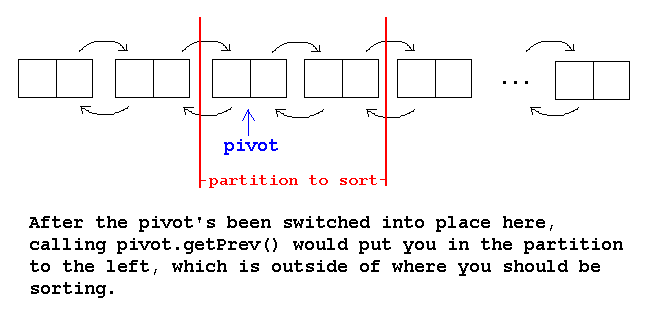Return to the Lecture Notes Index
15-111 Lecture 22 (Wednesday, March 13, 2003)
Overview
Today, in preparation for the lab, we will cover the insertion sort,
algorithm. We will also continue the thread form last class, and discuss
the implementation of quick sort.
Insertion Sort
A couple classes ago we talked about selection sort, where
you walk through the list to find the smallest item, and then insert it
into the lowest index. In this case, the index for each iteration is known,
while the value is not. Insertion sort is the opposite of
that: We know the value, but not the index where it goes. What does this
mean?
Let's look at an example:
We look at the first number, 59, and put it in our sorted list, which we
keep at the front of our current list. Since 59 is the only element in that
sub-list, we know it's sorted:
Now we take out the 51, and compare it to what's in our sorted list. Since
it's smaller than 59, it goes before it:
Next we take out the 39, and see that it goes before 51, so we insert it
there in our sorted list-so-far:
We keep doing this with each value until the list is sorted- the idea is
that you compare the latest value with each value in the sorted list until
you find the right place for it, and then you insert it there.
with a linked list, this would be pretty easy because you can just insert
before or after. But with an array or a vector, you would have to keep
shifting elements.
Another way to do the comparison is to always check against the largest
element in the sorted list to see if it needs shifting. If necessary, shift
the larger item, and continue checking, otherwise, insert element in the
space that's been created. Let's take a look at what the runtime for this
sort would be.
Runtime of Insertion Sort
There are n items in the list, so there will be n passes
through the list. The worst case for a pass is that we will have to push
n-1 elements to the right and then we have to move the element
that we're placing, so the total time would be n for one pass.
Since there are n passes, the runtime would be O(n2).
Recursive Quicksort using Linked Lists
Here is the some code for Quicksort using LinkedLists:
//why doubly linked list? because you need to be able to go from left to
// right as well as right to left.
class SortableDoublyLinkedList extends DoublyLinkedList{
public void quickSort(){
recursiveQuickSort(head, tail);
}
private void recursiveQuickSort(Node left, Node right){
if (right == left) //covers if only one item, or if list is empty
return;
Node savedLeft = left;
Node savedRight = right;
//now we know there are at least 2 elements.
//now we should pick a pivot point. Since doubly linked lists would be inefficient in picking the
center element, we're just going to pick the left one out of convenience.
Node pivot = left;
//remove pivot from partition
remove(left); //easy enough to write
//reset left
left = pivot.getNext();
while(left != right){
//look for an item on left that doesn't belong there:
while((left.getData().compareTo(pivot.getData())<=0) && (left!=right))
left = left.getNext();
while((right.getData().compareTo(pivot.getData())>=0) && (left!=right))
right = right.getPrev();
if (right != left)
swap(left, right);
}
insertBefore(pivot, left);
if(pivot != savedLeft) // why do we need these if clauses?
recursiveQuickSort(savedLeft, pivot.getPrev());
if(pivot != savedRight)
recursiveQuickSort(pivot.getNext(), savedRight);
}
}
So why do we need the "if (pivot != savedLeft)" and
"if (pivot != savedRight)" tests above? If we didn't, pivot.getPrev()
or pivot.getNext() might end up going out of the partition we're
trying to sort. What does this mean? Let's look at the following picture:

So that's how you would implement Quicksort with linkedLists.
Quicksort using Vectors
How different would the code be if we used Vectors instead of
linkedLists? Not much:
class SortableVector extends Vector{
public void quickSort(){
recursiveQuickSort(0, size());
}
private void recursiveQuickSort(int left, int right){
if (right == left) //covers if only one item, or if list is empty
return;
int savedLeft = left;
int savedRight = right;
//now we know there are at least 2 elements.
//now we should pick a pivot point. Since doubly linked lists would be inefficient in picking the
center element, we're just going to pick the left one out of convenience.
int pivot = (right-left)/2;
//remove pivot from partition -> swap to end of list
Comparable temp = (Comparable)getElement(right);
setElement(right, getElement(pivot));
setElement(pivot, temp);
//reset right and pivot for new positions
pivot = right;
right--;
while(left != right){
//look for an item on left that doesn't belong there:
while((getElement(left).compareTo(getElement(pivot))<=0) && (left!=right))
left++;
while((getElement(right).compareTo(getElement(pivot))<=0) && (left!=right))
right--;
if (right != left)
swap(left, right); /*the swap code would look just like the swap we did above to swap pivot and right*/
}
swap(pivot, right);
insertBefore(pivot, left);
if(pivot != savedLeft)
recursiveQuickSort(savedLeft, pivot-1);
if(pivot != savedRight)
recursiveQuickSort(pivot+1, savedRight);
}
}
